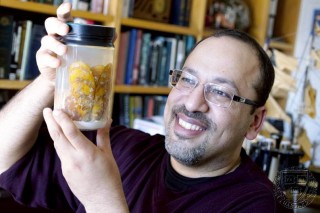In 1882, the USS Albatross set sail from Wilmington, Delaware with orders to carry out hydrographic and biological investigations in and around US waters. The USS Albatross was regarded as the first purpose-built research vessel, and was equipped with many of the latest technologies. She was renowned for numerous expeditions, and worked for the better part of three decades on advancing our understanding of the relationship between marine organisms and their environment.
Laying the Groundwork
Her first few years of service were spent in the waters off the eastern United States. Then in 1889 she set sail for San Francisco, California, to begin two decades of exploration primarily off the California coast. At the turn of the century, she carried some of the world’s leading marine scientists, including Alexander Agassiz, in and around these waters and beyond.

While dredging in the Gulf of California, scientists on board the USS Albatross brought up an unusually long and weighty clam. They noticed that it had very enlarged, red gills as well as no obvious gut. In 1916, D.W. Hall named this clam Calytpogena elongata, and went on to describe the myriad of other findings from the USS Albatross.
Little did they know that this clam was symbiotic with microbes that could use the toxic gas hydrogen sulfide to harness energy and convert carbon dioxide to sugars (this is very similar to what plants do with energy from the sun, but in this case the microbes rely on chemical energy instead as the deep sea is devoid of sunlight). It took scientists another 70 years to describe the symbiotic relationship of this clam and its cousins. Equally important, this clam is diagnostic of seafloor methane seeps, where they flourish and reach high densities. While the scientists and crew of the USS Albatross did not fully comprehend the significance of their observations, they did lay the groundwork for future expeditions.


Today, the R/V Falkor carries scientists from Harvard University, the Scripps Institution of Oceanography, Woods Hole Oceanographic Institution, and the University of Vienna on a three-week mission of science and discovery, visiting many of the same sites that the USS Albatross explored so many years ago. Today, however, we use sonar to map the seafloor fault systems and seeps, and to characterize the diversity of animals (including the unique clams) found in these habitats. In lieu of dredging, we use the Schmidt Ocean Institute’s state-of-the-art ROV SuBastian to collect discrete samples and conduct chemical tests among several different locations on the ocean floor.
On this expedition, our team will execute the second test deployment of an important emerging technology funded by NASA. The ABISS (Autonomous Biogeochemical Sampling System) is intended to be a prototype for spacecraft that will explore the oceans of the icy moons of Jupiter and Saturn.
The Act of Discovery
Like the USS Albatross, the R/V Falkor and the ROV SuBastian (as well as the suite of sophisticated technologies onboard) enable scientists unprecedented access to the deep sea. I am proud to be working alongside so many talented scientists and engineers during this expedition. Over the next 19 days, there will be ample opportunities for some grand discoveries! It is likely that we will generate data that re-shapes our understanding of how these underwater faults create habitats for animals, including commercially important fish like sole and red snapper. It is also probable that we will see things that we do not fully understand. In that case, I hope we do as excellent a job as our scientific predecessors in laying the foundation for future scientists to follow the clues we leave behind.
In the final analysis, what matters most is not that our names become associated with great findings, or that new species are named after us, but rather that we contribute to a greater scientific understanding through careful and thorough observation and documentation (sprinkled with a healthy dose of intuition and luck!). Our reward is in the act of discovery, in seeing someplace or something for the first time in the history of humankind. To paraphrase J.R.R. Tolkien: It’s an amazing business going out to sea. You step onto the boat, and if you keep your eyes open, there’s no knowing what you might encounter.

